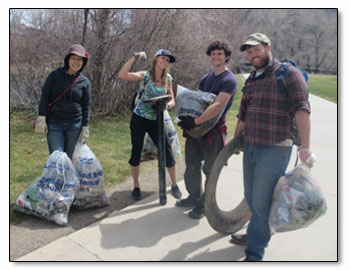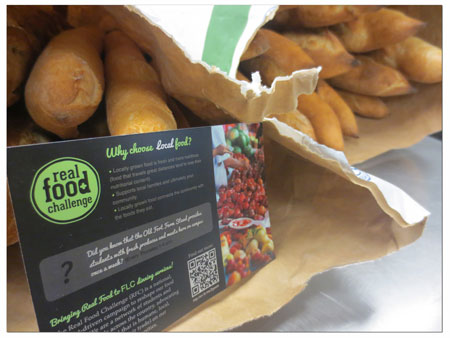Making change
New initiative helps FLC students turn environmental aspirations into reality
Fun in the Sun:: EC hosts online fundraiser
by Tracy Chamberlin
When students step through the doors of the Environmental Center at Fort Lewis College, they usually have big ideas and plenty of enthusiasm. But before they know it, the semester is over and that big idea never had a chance to bloom.
When students step through the doors of the Environmental Center at Fort Lewis College, they usually have big ideas and plenty of enthusiasm. But before they know it, the semester is over and that big idea never had a chance to bloom.
That’s why the center’s staff launched the Real Change Initiative in January, giving those students a how-to guide for putting their big ideas into action.
“It’s kind of like a skeleton of how the real world operates,” said Rachel Landis, interim coordinator for the center.
She called it an incredible tool that provides a blueprint for taking the ideas and the enthusiasm, and creating real change in the world.
The blueprint accounts for the potential impact of the project, the available resources and partnerships, community and campus involvement, as well as a way to help measure its effectiveness. Also known as “metrics,” they help students learn from the experience: what they did right; what they did wrong; and how it could work differently. And, it’s not just the students who learn from them. The next class that comes through the E.C.’s doors can also learn from and build upon those same projects.
Data collection is one of the most effective aspects of the initiative, according to Drew Walters, a senior biology major.
He utilized the initiative to help create the residence hall recycling program. In conjunction with the city’s new single-stream recycling program, Walters and his classmates worked to educate students and staff, as well as get plenty of recycling bins into the buildings and individual rooms.
They even hosted a recycling contest between the east and west sides of campus, with the west taking the win for the most recycling and the least contamination.
 |
| Forty-three volunteers, including FLC students, helped out at the recent Animas River Cleanup, which was initiated by students. The group collected 743 pounds of garbage, 45 pounds of which was recyclable./Courtesy photo |
But the first thing the team did was look at the initiative’s blueprint. They researched previous recycling efforts at Fort Lewis, as well as other campuses around the country. They collected data from waste audits, and figured out how to quantify the results of the contest and their project as a whole.
Walters said that’s one of the things that made it so effective. “The initiative stressed really concrete data,” he added.
And he wasn’t the only student to hit the ground running. Several programs were created this spring under the framework of the new initiative.
One of those programs was a zero-waste event service. Essentially a how-to guide for holding a zero-waste event on campus, it came complete with ideas for recycling at events, suggestions for what items could be reusable, and even educational materials.
Two events utilized the service this spring: SkyFest, an annual campus music festival held in April, and EcoFem Lenses, a panel discussion.
Another program fostered by the initiative was the Animas River Cleanup.
Alex Brooks, operations assistant with the Environmental Center, said the initiative helped the students behind the river cleanup organize and measure the impact of the project.
The cleanup crew had 43 volunteer recruits who collected 743 pounds of garbage. Through a waste audit, they calculated that 45 pounds was salvaged for recycling instead of heading to the landfill.
He added that it helped students throughout the semester develop stronger programs, quantify what they’ve achieved and understand what they were capable of accomplishing.
This not only helped them figure out how effective their ideas were, it helped them create databases that the next class could build upon like the Real Food Challenge, another program aided by the initiative.
The challenge is a national campaign designed to bring local, healthy, fair-trade foods to university and college campuses around the world.
Students, working with the Environmental Center and utilizing the initiative, acted as coordinators and contacted area producers and Fort Lewis’s food provider, Sodexo, in an effort to bring more local foods to campus.
What the initiative helped inspire was the creation of a database that listed those local providers as well as other information that could help the process continue long after graduation.
The next class would already have a list of who produces what foods locally, where some of the fair trade foods can be found, and how they can help Sodexo serve those items in the cafeteria.
“We really see it as a big opportunity that has positive effects for our campus … and our community,” Brooks said.
Landis said it’s the model of how she sees the Environmental Center operating. Students gain exposure to different methods, collect measurable data that the next class of students can build upon and, all the while, they’re making a difference.
“It’s great that the work we do actually creates change,” she said. After all, the goal is real change.
In this week's issue...
- September 11, 2025
- Back on top
After harrowing flying accident, local highliner steps back out with renewed mission
- September 11, 2025
- New order
Rule change for Land and Water Conservation Fund raises alarms
- September 4, 2025
- Armed with knowledge
Local community organizers work to ensure immigrant neighbors know their rights

